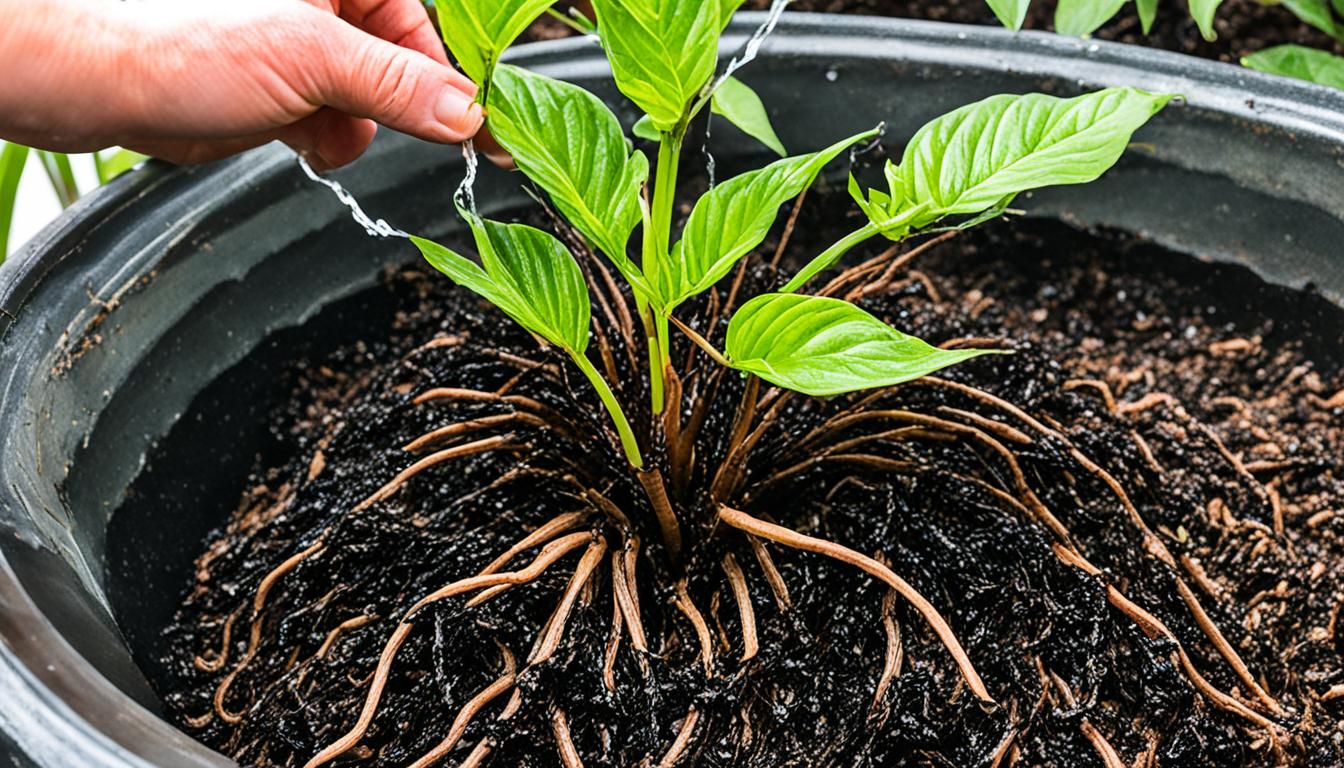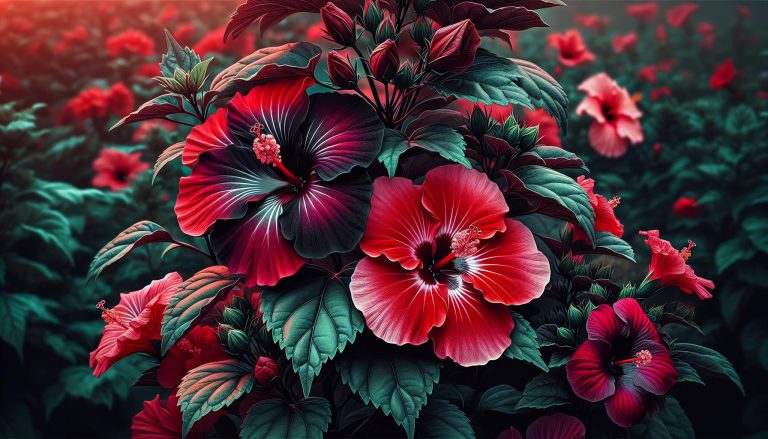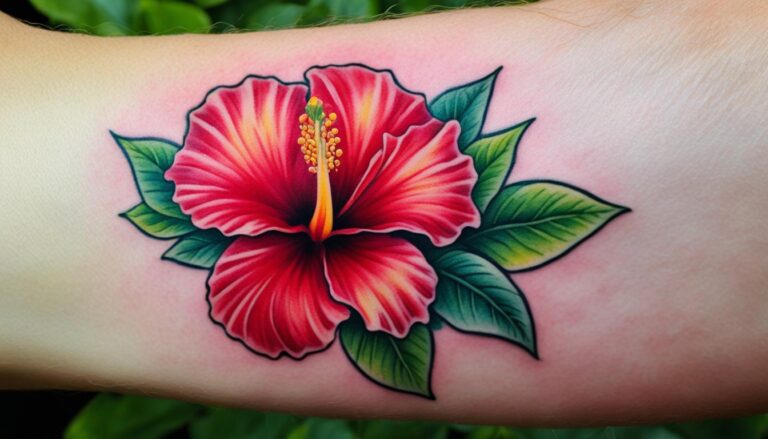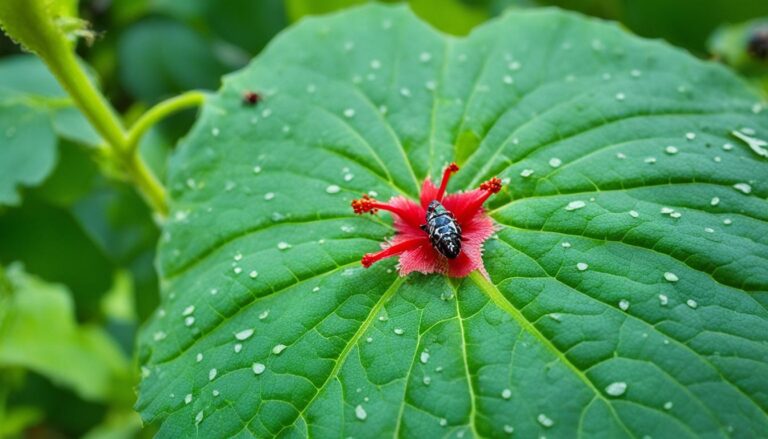Braided Hibiscus Tree Care Guide & Tips
When I first laid eyes on the braided hibiscus tree standing tall in my neighbor’s garden, I was instantly captivated by its elegance and tropical charm. Its slender trunks intertwined gracefully, creating a mesmerizing pattern that seemed to tell a story. I couldn’t help but wonder about the care and dedication that went into creating such a breathtaking masterpiece.
Curiosity got the better of me, and I reached out to my neighbor, Jane, who had lovingly nurtured this tree for years. As we sipped on cups of tea in her garden, she shared her wealth of knowledge about caring for braided hibiscus trees.
Key Takeaways:
- Proper watering and sunlight are crucial for braided hibiscus tree care.
- Choose well-drained soil and fertilize regularly to promote healthy growth and blooming.
- Prune and shape the tree to maintain its elegant appearance.
- Protect the tree from pests and diseases through regular inspection and preventive measures.
- During winter, provide adequate protection to ensure the tree’s survival.
Introduction to Braided Hibiscus Trees
Braided hibiscus trees have become a popular choice among garden enthusiasts and outdoor decor lovers due to their tropical allure and ability to serve as stunning focal points. Derived from the Hibiscus rosa-sinensis plant, these trees are commonly known as Chinese hibiscus or tropical hibiscus. They exude a sense of lushness and exotic beauty, making them ideal for decorative pots or as border plants. The striking feature of braided hibiscus trees lies in their unique and elegant braided trunks, which add an enchanting touch to any landscape.
The plant varieties belonging to Hibiscus rosa-sinensis have long been revered for their vibrant blooms and captivating appearance. With their attractive foliage and eye-catching flowers, braided hibiscus trees are sure to elevate the aesthetic appeal of any garden or outdoor space.
Now, let’s delve deeper into the world of braided hibiscus trees and explore the various aspects of their care and cultivation.
How to Form a Braided Hibiscus Tree
Forming a braided hibiscus tree is a fascinating and rewarding process that allows you to create a unique and visually stunning plant. With a bit of patience and care, you can transform young hibiscus plants into an exquisite braided masterpiece.
To begin the process of braiding hibiscus stems, you will need four young hibiscus trees with thin and flexible stems. These young plants should ideally be healthy and free from any pests or diseases.
Here’s a step-by-step guide on how to form a braided hibiscus tree:
- Select four young hibiscus plants with thin stems.
- Start by removing any leaves from the lower portion of the stems.
- Stand the plants close together and carefully intertwine the stems, starting from the base.
- Gently twist the stems in a braided pattern, gradually working your way up to the foliage.
- As you braid the stems, ensure that they are evenly distributed and tightly intertwined.
- Once you reach the top, use a soft string or plant tape to lightly tie the stems together to maintain the braided shape.
- Place the braided hibiscus tree in a decorative pot filled with well-draining soil.
- Water the tree gently, ensuring the soil is moist but not waterlogged.
Remember, it takes time and patience for the braided hibiscus tree to fully grow and mature. Regular maintenance, such as pruning and shaping, is necessary to keep the tree looking its best. With proper care, your braided hibiscus tree will become a stunning centerpiece in your garden or indoor space.
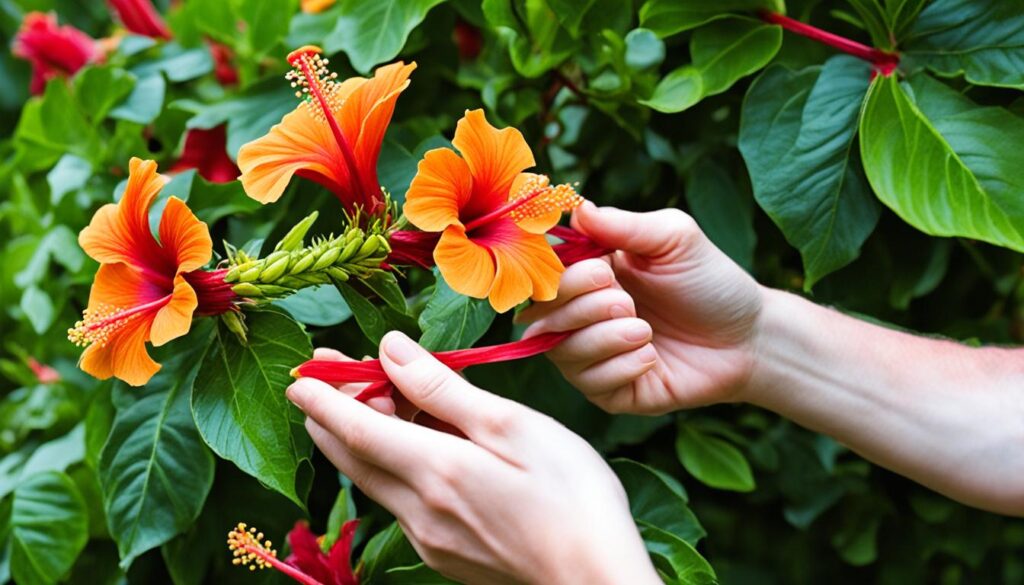
Now that you know how to form a braided hibiscus tree, let’s explore the watering and sunlight requirements to ensure your tree thrives and stays healthy.
Watering and Sunlight Requirements for Braided Hibiscus Trees
Proper watering is crucial for the health and vibrant bloom of a braided hibiscus tree. These trees thrive in well-drained soil and need regular watering, especially during the summer months. In general, braided hibiscus trees require watering every day in the summer, but the frequency should be halved in winter.
When it comes to sunlight, braided hibiscus trees prefer full sun exposure for at least 6-8 hours a day. The more sunlight they receive, the more they will thrive and produce beautiful blooms. However, it’s important to provide protection from intense midday heat to prevent leaf burn.
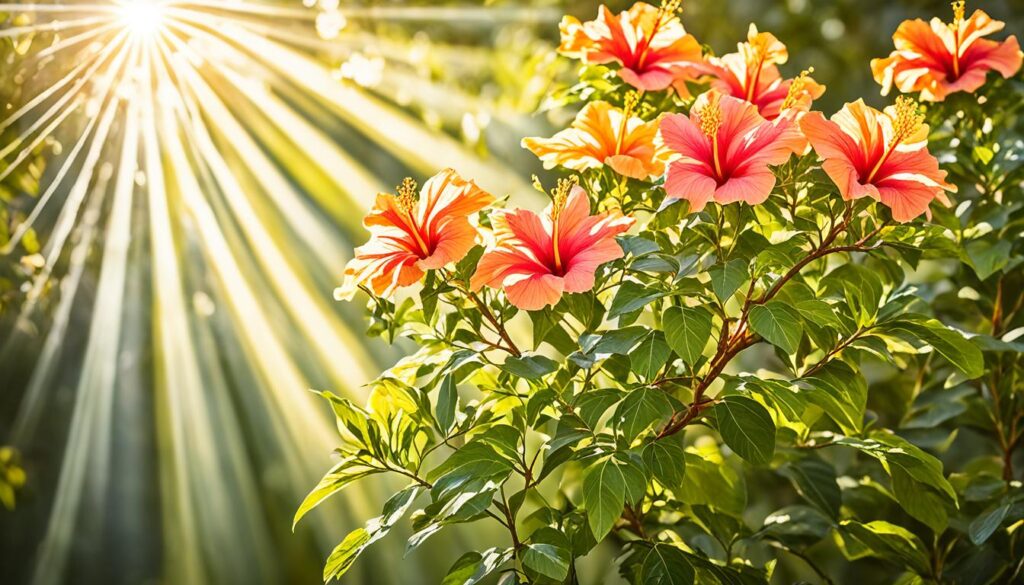
To ensure proper watering, check the moisture level of the soil regularly. The top inch of soil should feel slightly dry before watering again. Avoid overwatering, as it can lead to root rot and other moisture-related issues. Using a well-draining potting mix can help prevent waterlogged soil.
During the winter months, when the plant is in its dormant phase, reduce watering frequency. Water the tree only when the soil feels dry to the touch. This will prevent excessive moisture retention and help maintain the health of the tree.
Remember to adjust your watering schedule based on the specific needs of your braided hibiscus tree. Factors such as temperature, humidity, and pot size can influence the frequency of watering required.
By providing the right amount of water and sunlight, you can ensure that your braided hibiscus tree thrives and graces your space with its lush foliage and vibrant blooms.
Soil and Fertilizing Requirements for Braided Hibiscus Trees
When it comes to cultivating healthy and vibrant braided hibiscus trees, the right soil and fertilization play a crucial role. These trees are highly adaptable and can thrive in various soil types as long as the soil is well-drained and consistently moist.
For optimal growth and nourishment, braided hibiscus trees prefer slightly acidic soil. A pH level between 6.0 and 7.0 is ideal. Adding organic matter like compost to the soil can help retain moisture and provide essential nutrients.
Regular fertilization is essential to promote healthy growth and vibrant blooming. Using a slow-release liquid fertilizer every two weeks during the growing season will ensure that your braided hibiscus trees receive the necessary nutrients. It’s important to choose a fertilizer specifically formulated for hibiscus trees and follow the instructions on the packaging for proper application.
Key Tips for Fertilizing Braided Hibiscus Trees:
- Apply a slow-release liquid fertilizer every two weeks during the growing season.
- Use a fertilizer formulated specifically for hibiscus trees.
- Follow the instructions on the fertilizer packaging for application rates and frequency.
- Avoid over-fertilization, as it can lead to excessive foliage growth at the expense of blooms.
By providing your braided hibiscus trees with the right soil conditions and regular fertilization, you’ll ensure their overall health and encourage a vibrant and beautiful display of flowers.
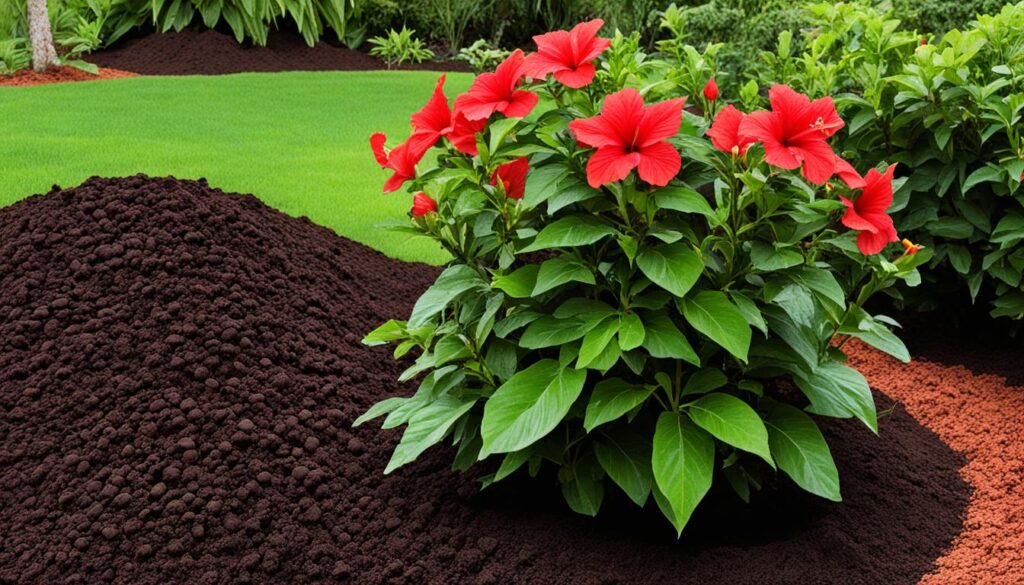
| Soil Type | Description |
|---|---|
| Well-drained soil | Allows excess water to drain away to prevent root rot |
| Moist soil | Retains adequate moisture for the hibiscus tree |
| Slightly acidic soil | Provides ideal pH levels for optimal growth |
| Added compost | Improves soil fertility and moisture retention |
Pruning and Shaping a Braided Hibiscus Tree
Pruning and shaping a braided hibiscus tree is crucial for maintaining its appearance and ensuring proper growth. Once you have braided the stems, it’s important to shape the canopy of the tree by pruning out any straggly or unwanted stems. Regular pruning is required to keep the tree in its desired shape over time.
In order to promote healthy growth, it is best to prune your braided hibiscus tree in early spring or late winter, before the plant starts actively growing again. This timing allows the tree to recover from pruning stress while preparing for a new growing season.
Regular maintenance is essential for preventing excessive seed formation and encouraging side shoot growth. By removing any excess growth, you can maintain the tree’s desired shape and ensure that it remains healthy and vibrant.
Pruning Tips for Braided Hibiscus Trees
When pruning your braided hibiscus tree, keep the following tips in mind:
- Start by inspecting the tree and identifying any dead, damaged, or diseased branches. These should be pruned to maintain the overall health of the tree.
- Remove any crossing or rubbing branches to prevent damage and ensure proper airflow.
- Use clean and sharp pruning tools to make clean cuts. This helps reduce the risk of infection and promotes faster healing.
- Always prune just above a bud or node. This encourages new growth and prevents the tree from looking bare.
- Avoid pruning more than one-third of the tree’s total growth in a single pruning session. Pruning too much at once can stress the tree and affect its overall health.
Shaping a Braided Hibiscus Tree
When shaping your braided hibiscus tree, follow these steps:
- Step back and examine the tree from different angles to determine the desired shape.
- Identify any areas that need adjustment or reshaping.
- Prune the branches accordingly to achieve the desired shape.
- Regularly trim and maintain the tree’s shape throughout the growing season.
By regularly pruning and shaping your braided hibiscus tree, you can ensure that it maintains its elegant appearance and continues to thrive.
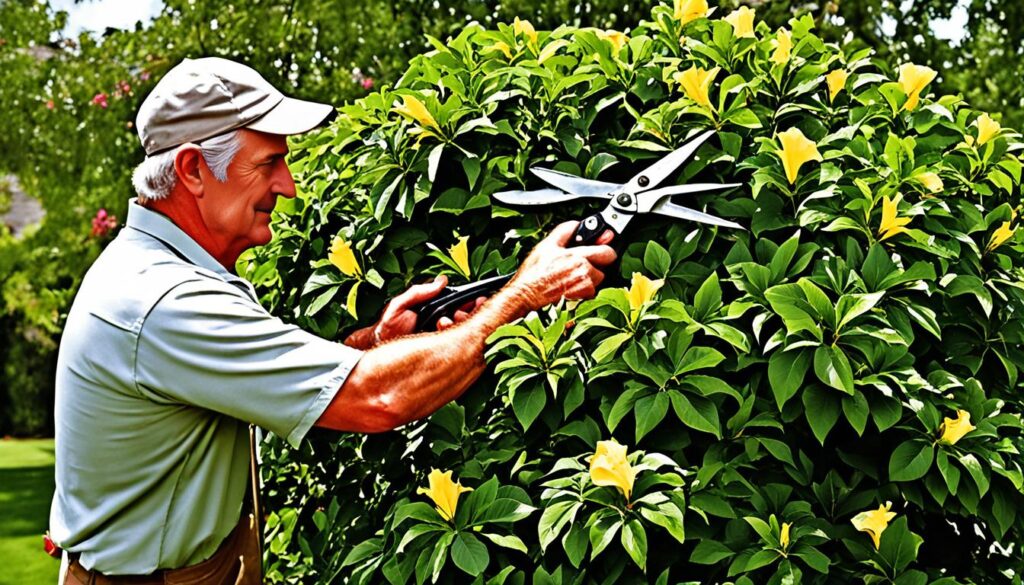
| Benefits of Pruning and Shaping a Braided Hibiscus Tree | Why It’s Important |
|---|---|
| Promotes healthy growth | Regular pruning encourages new growth and prevents the tree from becoming overgrown. |
| Maintains the desired shape | By shaping the tree through pruning, you can ensure that it retains its elegant and upright growth habit. |
| Prevents excessive seed formation | Pruning helps redirect the tree’s energy towards producing blooms rather than seeds. |
| Encourages side shoot growth | By removing excess growth, you can promote the development of new branches and a fuller canopy. |
Protecting Braided Hibiscus Trees from Pests and Diseases
Braided hibiscus trees, like any other plants, can be prone to pests and diseases that can affect their health and overall well-being. By taking proactive measures and implementing effective pest control and disease prevention strategies, you can ensure the longevity and vibrancy of your braided hibiscus tree.
Common Pests
Aphids, mealybugs, and spider mites are among the common pests that can infest braided hibiscus trees. These tiny creatures can cause significant damage by sucking the sap from the leaves and stems, leading to yellowing, stunted growth, and an overall decline in the plant’s health.
To control and prevent pest infestations, it’s important to regularly inspect your hibiscus tree for signs of pests. Look for clusters of insects, sticky residue (known as honeydew), or distorted leaves. If you notice any of these indicators, take immediate action to avoid further damage.
Applying neem oil or using insecticidal soap can be effective remedies for controlling and eliminating aphids, mealybugs, and spider mites. Ensure that you follow the instructions on the product label and apply the treatment as directed.
Common Diseases
Hibiscus trees, including braided varieties, can be susceptible to certain diseases such as leaf spot, root rot, and powdery mildew. These diseases can compromise the health and appearance of your tree, resulting in wilting, yellowing or browning leaves, and poor blooming.
To prevent disease development, it’s essential to provide your braided hibiscus tree with optimal growing conditions. This includes ensuring proper watering practices, avoiding overwatering which can lead to root rot, and promoting good air circulation around the plant.
Regularly pruning your tree to remove dead or infected plant material can also help prevent the spread of diseases. Make sure to sanitize your pruning tools between cuts to avoid cross-contamination.
A Visual Guide to Common Hibiscus Tree Pests and Diseases
| Pest/Disease | Description | Signs and Symptoms | Prevention and Treatment |
|---|---|---|---|
| Aphids | Small, soft-bodied insects that feed on plant sap | Clusters of insects on leaves, distorted growth, sticky residue (honeydew) | – Regularly check for aphid infestations – Apply neem oil or insecticidal soap – Introduce beneficial insects, such as ladybugs |
| Mealybugs | Small, white, cottony insects that gather in protected areas of the plant | White, cottony clusters on leaves and stems | – Inspect for mealybug infestations regularly – Apply neem oil or insecticidal soap – Use a cotton swab dipped in rubbing alcohol to remove individual mealybugs |
| Spider Mites | Tiny pests that cause leaves to appear stippled and yellowed | Tiny webbing on leaves, stippled yellow or discolored foliage | – Regularly inspect for spider mites – Apply a miticide or insecticidal soap – Increase humidity levels around the plant |
| Leaf Spot | Fungal disease that causes circular spots on leaves | Dark spots with yellow halos on leaves, leaf drop | – Remove and destroy infected leaves – Ensure proper spacing between plants for good air circulation – Avoid overhead watering |
| Root Rot | Fungal disease that affects the roots, causing them to rot | Yellowing leaves, wilting, root decay | – Avoid overwatering and ensure proper drainage – Use well-draining soil – Apply a fungicide if necessary |
| Powdery Mildew | Fungal disease that appears as a white, powdery coating on leaves | White powdery coating on leaves, stunted growth | – Provide good air circulation around the plant – Remove and destroy infected leaves – Apply a fungicide if necessary |
By being vigilant and implementing effective pest control and disease prevention methods, you can keep your braided hibiscus tree healthy and thriving. Regularly inspect your tree, provide optimal growing conditions, and take immediate action at the first sign of pests or diseases. With proper care and attention, your braided hibiscus tree will continue to bring beauty and tropical charm to your outdoor space.
Winter Care for Braided Hibiscus Trees
When the winter season arrives, it’s crucial to take proper steps to protect your braided hibiscus trees from frost and cold temperatures. By following these winter care tips, you can ensure the health and vitality of your beloved trees, allowing them to thrive year after year.
1. Indoor Protection
One of the most effective ways to safeguard your braided hibiscus tree during winter is by bringing it indoors or relocating it to a warmer area. Find a spot in your home with ample sunlight, such as near a south-facing window, and place the tree there. Ensure the tree is protected from drafts. This will help maintain a stable temperature for the tree and protect it from extreme cold.
2. Digging Up the Tree
If you have the option, consider digging up your braided hibiscus tree before the temperatures drop significantly. Carefully remove the tree from the ground and transplant it into a large pot. This way, you can easily move the tree indoors when needed, ensuring its survival during harsh winter conditions. Choose a container that provides enough room for the tree’s roots to grow.
3. Sunlight and Watering
During winter, your braided hibiscus tree will still need access to adequate sunlight. Place the tree near a sunny window or use artificial grow lights to provide the necessary light for photosynthesis. Be sure to monitor the soil moisture levels and water the tree when the top inch of soil feels dry. Avoid overwatering, as this can lead to root rot.
4. Minimize Fertilization
While your braided hibiscus tree may benefit from regular fertilization during the growing season, it’s best to minimize or eliminate fertilization during the winter months. The tree’s growth slows down during this time, and excessive fertilization can disrupt its natural cycle. Resume fertilization in the spring when the tree enters its active growth phase again.
5. Transitioning Back Outside
When spring arrives and the risk of frost has passed, it’s time to transition your braided hibiscus tree back outside. Before moving it outdoors, gradually introduce the tree to brighter light by placing it in a partially shaded area for a few days. Then, gradually increase its exposure to direct sunlight. This gradual transition will prevent leaf burn and help the tree adjust to the outdoor conditions.
| Winter Care Tips for Braided Hibiscus Trees |
|---|
| Bring the tree indoors or relocate it to a warmer area. |
| If possible, dig up the tree and transplant it into a large pot. |
| Provide adequate sunlight by placing the tree near a sunny window or using grow lights. |
| Monitor soil moisture and water the tree when the top inch of soil feels dry. |
| Minimize or eliminate fertilization during the winter months. |
| Gradually transition the tree back outside by increasing its exposure to sunlight. |
By following these winter care tips, you can ensure that your braided hibiscus trees remain healthy and vibrant, ready to flourish when the warmer months return.
Conclusion
In conclusion, caring for a braided hibiscus tree involves several essential aspects. Paying close attention to watering, sunlight, soil, pruning, and protection from pests and diseases is crucial for the tree’s overall health and vibrancy. By following the guidelines outlined in this care guide, you can ensure that your braided hibiscus tree thrives, adding a touch of tropical beauty to your garden or outdoor space.
Remember to provide regular watering, especially during the summer months, and ample sunlight exposure of at least 6-8 hours a day. Use well-drained soil and consider adding compost to retain moisture. Periodically prune and shape the tree to maintain its desired appearance and prevent excessive seed formation. Additionally, stay vigilant for pests and diseases, promptly addressing any signs of infestation or illness.
With proper care and maintenance, your braided hibiscus tree will reward you with its lushness and elegance. Enjoy the unique beauty and tropical ambiance it brings to your outdoor environment. By incorporating these final thoughts on braided hibiscus tree care into your routine, you can ensure the long-term success and stunning display of your beloved tree.

